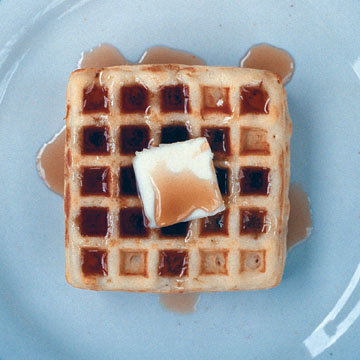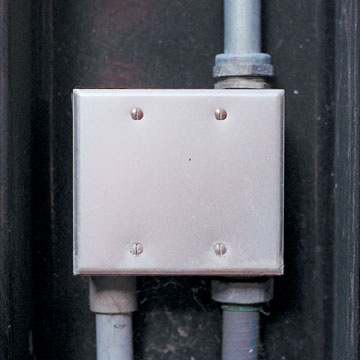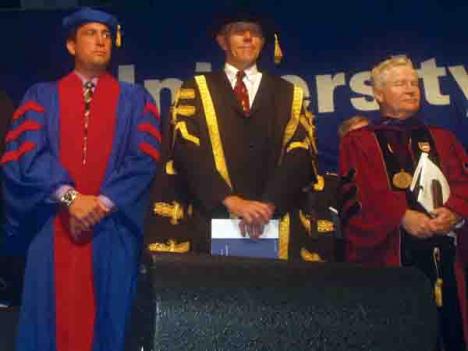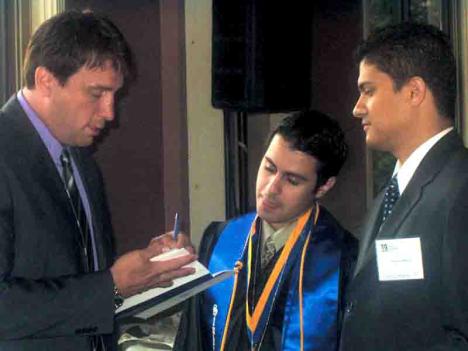Artists at Work

Photos of Derick Mangus´s installation entitled 44 Squares. Works of art by Mangus can be seen, alongside many others, in the Walter Grossmann Gallery on the fifth floor of Healey Library throughout the month of May.
May 19, 2003
What do you get when you combine cowboys and heavy construction? Answer: An art exhibit on the fifth floor of Healey Library showcasing the stylistic strangeness of Justin Hughes, for whom the show is a first, and Dereck Mangus. The space in the gallery is divided evenly with opposing sides and opposing takes on art facing one another.
At the opening, I had the luck to be able to speak to the parents of Justin Hughes and ask them about their feelings on his Self-Portrait With Parents (next page,) a picture displaying his father and mother on either side of the artist with the former clad in jockey shorts and a face full of shaving cream and the other wearing work clothes. Hughes had managed to catch them as they were readying themselves for work one morning.
His mother commented, “He had bought this new camera and told us to come over and take a picture. He said it was for some school assignment. That was two years ago. I’m glad I bothered to get dressed that morning.” The picture was used in invitations for the Hughes/Mangus show and, with one copy pinned to a library building elevator. Apparently, while riding the elevator up, Hughes’ parents had the good fortune to be recognized, even as his mother put her hands over the picture. She took it in stride with a mix of humor and weariness and warned him about getting release forms for the next time claiming that he could get sued.
Hughes’ work remains mostly united under an umbrella theme of self-portraits running the spectrum of amusing to amazing when one looks at what his facial muscles are capable of. Whether it’s changing hats, lighting, or expressions, Hughes seems to have a knack for presenting a different persona for every picture, making it difficult to determine just what emotions are running through his head.
In his Not Sex series, we see the contortions of his countenance not limited to his face but his neck and shoulders as well. The effort behind the clenching and distortion of each look stands out as clearly as the tendons and muscles straining beneath the skin making for an interesting if somewhat macabre effect. The crowning piece of his self-portraits was the Self-Portrait as Celebrity Cardboard Cutout, featuring a life-sized photo of Hughes dressed as a cowboy complete with pistol, hat, and boots. Clearly, Hughes takes himself with a grain of salt.
If Hughes’ work runs to the ridiculous, then Mangus’ work is the soul of seriousness. The latter’s fascination and focus is on photography. Using the black and white digital imagery, Mangus’ unique approach to graphics shows in his large blowups of the phases of construction of buildings on college campuses, and created by collaging of various negatives from each stage.
His series UMB No. 1-4 depicts a hodgepodge of colliding perspectives on the building of the Campus Center through the intermingling of pieces of negatives and has attracted the interest of officials in search of art to decorate the new Campus Center with photos marking the evolution of the structure from the steel skeleton towards its finished form. Two other photo series describe identical developments at Harvard and M.I.T.
In another playful series showing lost mittens, Mangus manages to unite these lonely gloves with their other halves using the power of technology. For each framed picture of an actual glove, there is a photographed, reversed image that masquerades as the missing piece’s partner. Mangus’ humor is more subtle, taking simple subjects, and giving them a new take. Even his “pretentious paragraph” in his artist statement, as he refers to it, shows a talent for self-deprecation.
Mangus’ mom had this to say about her son, “Even as a child he was always doing artwork. One Christmas when he was eight or ten, he took his Legos and made Santa and his sleigh, complete with reindeer and wrapped them in bows. I was amazed by his spatial perception.”
My favorite piece of all of his work was the 44 Squares, 44 pictures set up in squares featuring different subject matters whose commonality lay in their shared shapes. From a slice of cheese to a chessboard to carvings from the buildings, some of the associations were bound to provoke a smile from the viewer who stood and made the necessary mental connections.
Both artists have displayed a certain quirky attitude in their take on art. At first glance, the subject matter seems entirely at odds with one another, but when one takes the time to become familiar with each piece, the underlying eccentric bits of humor form a coherent and slightly bizarre matched set. Take the time to check out the Hughes/Mangus show. It will set your sides aching.























































